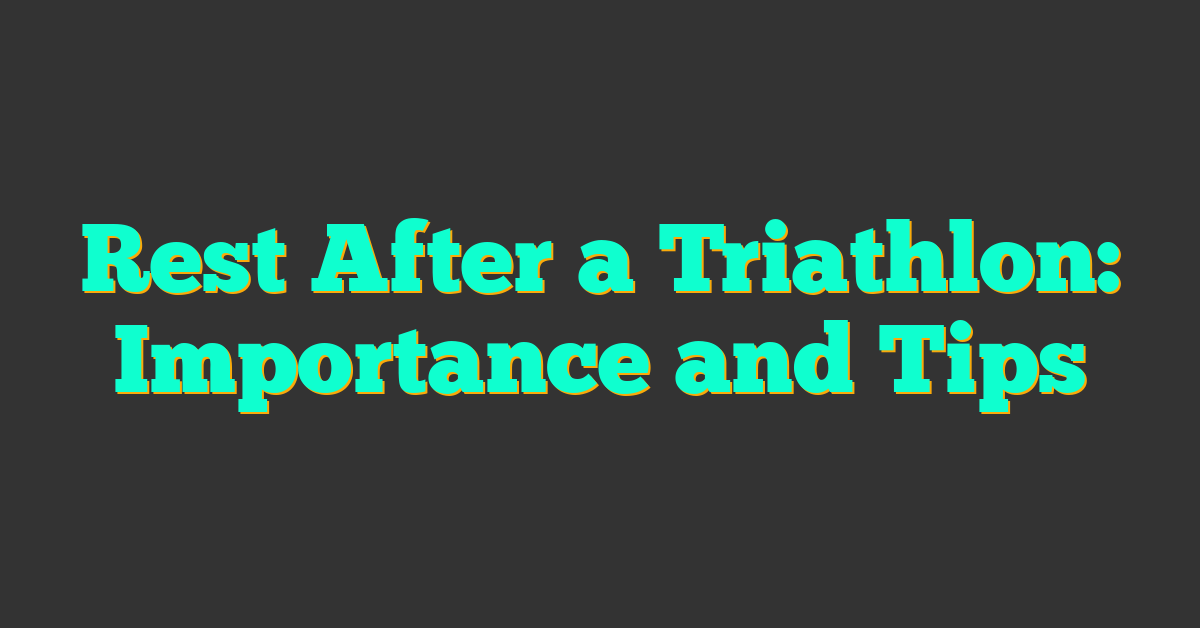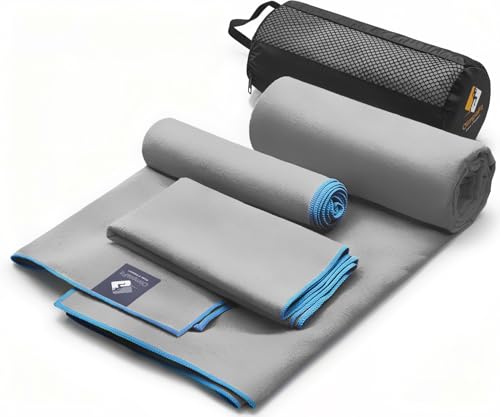Rest is a critical component of any triathlon training plan. After pushing your body to the limit during a triathlon race, it is essential to allow your body to recover properly. The recovery process is just as important as the training process, and it involves more than just taking a few days off from training. In this article, we will explore the importance of rest after a triathlon and provide you with some post-race recovery strategies to help you optimize your recovery.

Understanding triathlon recovery is crucial to your overall performance. Triathlon is a demanding sport that requires a lot of physical and mental energy. The recovery process is a crucial part of the training cycle, and it allows your body to repair and rebuild after intense workouts. Proper recovery can help you avoid injuries, improve your performance, and help you reach your goals faster. In the next section, we will discuss some post-race recovery strategies to help you optimize your recovery after a triathlon.
Key Takeaways
- Rest is a critical component of any triathlon training plan.
- Post-race recovery strategies are essential to help you optimize your recovery after a triathlon.
- Proper recovery can help you avoid injuries, improve your performance, and help you reach your goals faster.
Understanding Triathlon Recovery
https://www.youtube.com/watch?v=037jaCDnM8Y&embed=true

After completing a triathlon, your body goes through a lot of stress and fatigue. Recovery is a crucial aspect of training, and it is essential to take it seriously to avoid injury and ensure that your body is ready for the next race. Here are some things you need to know about triathlon recovery.
The Recovery Period
The recovery period is the time your body needs to rest, repair, and rebuild after a triathlon. The duration of the recovery period depends on the length and intensity of the race, as well as your fitness level. For example, if you have just completed a sprint triathlon, you may need only a few days of recovery, whereas a full Ironman may require up to four weeks.
During the recovery period, it’s essential to listen to your body. If you feel tired, take a break, and rest. Your body needs time to recover, and pushing yourself too hard can lead to injury or burnout. It’s also important to stay hydrated and eat a balanced diet to help your body recover.
Importance of Rest Days
Rest days are an essential part of triathlon recovery. They give your body time to rest and repair, and they help prevent injury and burnout. Rest days don’t mean you have to be completely inactive; you can still do light activities like walking, yoga, or swimming.
It’s important to remember that rest days are not a sign of weakness. They are a crucial part of your training, and skipping them can lead to overtraining and decreased performance. Rest days also help you mentally recharge, which is essential for staying motivated and focused on your goals.
In conclusion, recovery is a crucial aspect of triathlon training. The recovery period and rest days are essential for allowing your body to rest, repair, and rebuild after a race. Remember to listen to your body, stay hydrated, and eat a balanced diet to help your body recover.
Post-Race Recovery Strategies
https://www.youtube.com/watch?v=AvL_5_Lhse0&embed=true
Congratulations on completing your triathlon! You’ve pushed your body to its limits and now it’s time to focus on recovery. Post-race recovery is just as important as training, and it’s essential to give your body the time and resources it needs to heal and rebuild. Here are some post-race recovery strategies to help you bounce back and get back to training.
Active Recovery Techniques
Active recovery involves low-intensity activities that help your body recover from the physical stress of the race. Gentle exercise can help improve blood flow, reduce muscle soreness, and prevent stiffness. Some examples of active recovery techniques include:
- Swimming: Swimming is a low-impact exercise that can help you recover from the triathlon. It can help you rehydrate, flush out lactic acid, and loosen up your muscles.
- Yoga: Yoga can help you stretch out tight muscles and improve your flexibility. It can also help you relax and reduce stress.
- Walking: Walking is a low-intensity exercise that can help improve blood flow and reduce muscle soreness. It’s a great way to get some fresh air and enjoy the outdoors.
Nutrition and Hydration
Proper nutrition and hydration are essential for post-race recovery. Your body needs protein, carbohydrates, electrolytes, and minerals to repair and rebuild muscle tissue, replenish glycogen stores, and rehydrate. Here are some nutrition and hydration tips to help you recover:
- Rehydrate: Drink plenty of water and sports drinks to replace fluids lost during the race. Aim to drink at least 16-20 ounces of fluids for every pound of body weight lost during the race.
- Eat protein and carbohydrates: Eat a meal that contains both protein and carbohydrates within 30 minutes of finishing the race. This will help replenish glycogen stores and repair muscle tissue. Good options include a turkey sandwich, grilled chicken with rice, or a protein smoothie.
- Replace electrolytes: Sports drinks can help replace electrolytes lost during the race. You can also eat foods that are high in electrolytes, such as bananas, avocados, and nuts.
- Avoid dehydration: Dehydration can prolong your recovery time and make you feel even more fatigued. Make sure to drink plenty of fluids throughout the day and monitor your urine color to make sure you’re staying hydrated.
By following these post-race recovery strategies, you’ll be able to recover faster and get back to training. Remember to listen to your body and give it the time and resources it needs to heal.
Physical Recovery Modalities
https://www.youtube.com/watch?v=zr3GauiQq4s&embed=true
After completing a triathlon, your body needs time to recover. One way to help with recovery is by using physical recovery modalities. These modalities can help reduce muscle soreness, improve circulation, and promote relaxation. Here are a few modalities you can try:
Massage and Foam Rolling
Massage and foam rolling are two great ways to help your muscles recover after a triathlon. A massage therapist can help you target specific areas of your body that are sore or tight. Foam rolling, on the other hand, is a self-massage technique that you can do on your own. It involves using a foam roller to apply pressure to different parts of your body.
Foam rolling can help improve circulation, reduce muscle soreness, and increase flexibility. When using a foam roller, it’s important to start slowly and gradually increase the pressure. You should also focus on the areas of your body that are the most sore or tight.
Cold and Heat Therapies
Another way to help your muscles recover is by using cold and heat therapies. Ice baths, for example, can help reduce inflammation and muscle soreness. To take an ice bath, fill a bathtub with cold water and ice, and soak for 10-15 minutes.
Heat therapies, such as contrast showers, can also be beneficial. Contrast showers involve alternating between hot and cold water. This can help improve circulation and reduce muscle soreness.
Compression garments and other recovery tools can also be helpful in promoting physical recovery after a triathlon. Compression garments can help improve circulation and reduce muscle soreness, while recovery tools such as massage balls and percussion massagers can help target specific areas of your body.
« Remedial Massage Benefits: Relieve Pain and Improve Mobility
Rethinking Race Priorities: Prioritizing Equity and Inclusion »
Overall, physical recovery modalities can be a great way to help your body recover after a triathlon. By incorporating these modalities into your recovery routine, you can reduce muscle soreness, improve circulation, and promote relaxation.
Training After Triathlon
https://www.youtube.com/watch?v=dK9SDSqLlao&embed=true
Congratulations on completing your triathlon! After your race, it’s important to give your body the rest it needs to recover. But once you’ve had enough rest, you might be wondering how to get back into your normal training routine. Here are some tips to help you adjust your training program and return to normal training.
Returning to Normal Training
The first thing to keep in mind is that you should take it easy when returning to normal training. Your body has just gone through a lot of stress, and it needs time to recover. Start with low-intensity workouts, such as easy runs or bike rides. Don’t try to push yourself too hard too soon.
As you start to feel more comfortable, you can gradually increase the intensity of your workouts. Strength training can also help you build endurance and improve your fitness level. Just make sure to listen to your body and not overdo it.
Adjusting Your Training Program
When you’re ready to start adjusting your training program, there are a few things to keep in mind. First, make sure to set realistic goals based on your current fitness level. You don’t want to set yourself up for failure by setting goals that are too ambitious.
Next, consider incorporating some cross-training into your routine. This can help you avoid overuse injuries and improve your overall fitness. For example, you might try swimming or yoga to supplement your running and cycling.
Finally, be sure to follow some general guidelines for post-triathlon training. Make sure to get enough rest and recovery time, and don’t be afraid to take a break if you need it. Remember that it’s important to listen to your body and adjust your training program accordingly.
By following these tips, you can safely and effectively return to your normal training routine after your triathlon. Just remember to take it slow, set realistic goals, and listen to your body.
Lifestyle Factors Affecting Recovery
https://www.youtube.com/watch?v=sP1m5JCPuwQ&embed=true
Recovery after a triathlon is a crucial aspect of your overall performance. While training and nutrition are important factors, your lifestyle choices can also have a significant impact on your recovery. Here are two important lifestyle factors that can affect your recovery:
Sleep and Rest
Getting enough sleep and rest is essential for your body to recover after a triathlon. During sleep, your body repairs damaged tissues and replenishes energy stores. Lack of sleep can lead to decreased performance, increased risk of injury, and slower recovery.
It is recommended that adults get 7-9 hours of sleep per night. If you are an athlete or a triathlete, you may need even more sleep to ensure optimal recovery. Additionally, taking naps during the day can also help your body recover faster.
Avoiding Harmful Substances
Caffeine and alcohol are two substances that can negatively impact your recovery after a triathlon. Caffeine is a stimulant that can interfere with your sleep and cause dehydration. While it can provide a boost of energy during the race, it is important to limit your caffeine intake after the race.
Alcohol, on the other hand, can impair your body’s ability to recover by interfering with your sleep and dehydrating your body. It is recommended that you avoid alcohol for at least 48 hours after the race to ensure optimal recovery.
Age can also be a factor in recovery. As you age, your body may take longer to recover from intense physical activity. It is important to listen to your body and adjust your recovery plan accordingly.
In summary, getting enough sleep and avoiding harmful substances such as caffeine and alcohol can have a positive impact on your recovery after a triathlon. By taking care of your body and making smart lifestyle choices, you can ensure that you are performing at your best.
Frequently Asked Questions
https://www.youtube.com/watch?v=13Bjb2dsPxk&embed=true
What’s the ideal recovery time following a triathlon?
The ideal recovery time following a triathlon varies depending on the length of the race and your fitness level. For a sprint triathlon, you can recover in as little as a few days. However, for longer races like an IRONMAN, it can take several weeks to fully recover. It’s important to listen to your body and give yourself enough time to recover before jumping back into intense training.
Can you suggest some post-triathlon recovery foods?
After a triathlon, it’s important to refuel your body with the right nutrients. Some good post-triathlon recovery foods include lean protein like chicken or fish, complex carbohydrates like sweet potatoes or quinoa, and healthy fats like avocado or nuts. Additionally, make sure to hydrate with water and electrolyte-rich beverages like sports drinks.
What does a typical triathlon recovery week look like?
A typical triathlon recovery week involves light exercise, rest, and recovery techniques like foam rolling or stretching. You should avoid intense workouts and focus on low-impact activities like swimming, cycling, or yoga. Make sure to get plenty of sleep and hydrate with water and electrolyte-rich beverages.
What are the best practices for sprint triathlon recovery?
For sprint triathlon recovery, it’s important to focus on rest and recovery techniques like foam rolling or stretching. You can also incorporate light exercise like swimming or cycling to help flush out lactic acid and promote blood flow. Make sure to hydrate with water and electrolyte-rich beverages and refuel with healthy post-workout snacks.
How do I deal with fatigue after completing an IRONMAN?
Fatigue is common after completing an IRONMAN, and it’s important to give yourself enough time to recover. Focus on rest and recovery techniques like foam rolling or stretching, and avoid intense workouts for several weeks. Make sure to hydrate with water and electrolyte-rich beverages, and refuel with healthy post-workout snacks.
What should I do after finishing my first triathlon?
After finishing your first triathlon, take some time to celebrate your accomplishment! It’s important to focus on rest and recovery in the days following the race. Incorporate light exercise like swimming or cycling, and make sure to hydrate with water and electrolyte-rich beverages. Listen to your body and give yourself enough time to recover before jumping back into intense training.










